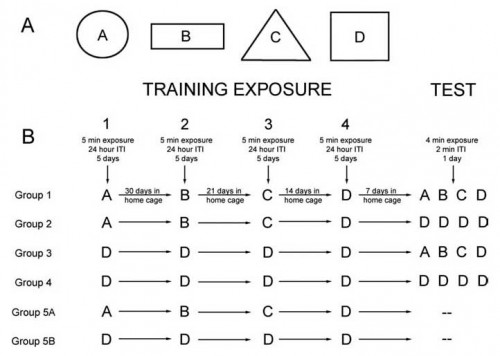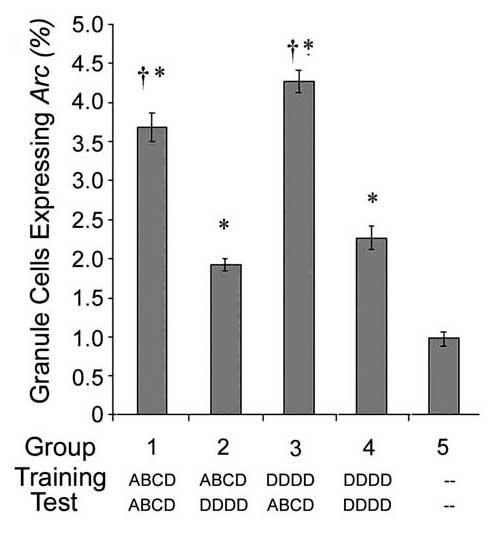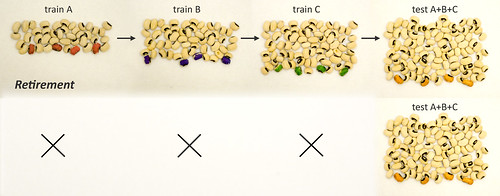![]() And here we have the latest, craziest hypothesis of granule cell function. Crazy not because the authors have lost their minds but because the story of the dentate gyrus, where adult neurogenesis occurs, is becoming more peculiar every day. The underlying premise of this paper by Alme et al. (which we will examine later) is that granule neurons go through a critical period during their development when they are more likely to contribute to memory encoding. Here it’s hypothesized that, once the critical period is over, they shut down. Forever. Hundreds of thousands of neurons never to be used again. It’s not every day you get to read such bold and novel ideas. Their hypothesis has similarities with that proposed by Aimone 2006, that adult neurogenesis causes different cohorts of neurons to be immature at different phases of an animal’s life, thereby separating memories according to time. The question here is whether these neurons can be reactivated once their critical period is over.
And here we have the latest, craziest hypothesis of granule cell function. Crazy not because the authors have lost their minds but because the story of the dentate gyrus, where adult neurogenesis occurs, is becoming more peculiar every day. The underlying premise of this paper by Alme et al. (which we will examine later) is that granule neurons go through a critical period during their development when they are more likely to contribute to memory encoding. Here it’s hypothesized that, once the critical period is over, they shut down. Forever. Hundreds of thousands of neurons never to be used again. It’s not every day you get to read such bold and novel ideas. Their hypothesis has similarities with that proposed by Aimone 2006, that adult neurogenesis causes different cohorts of neurons to be immature at different phases of an animal’s life, thereby separating memories according to time. The question here is whether these neurons can be reactivated once their critical period is over.
 The main experiment is illustrated on the left. Groups of rats were either exposed to 4 different contexts (A,B,C,D) or a single context (D) over the course of several months (TRAINING EXPOSURE). Then rats were either exposed to all 4 contexts or the single context over the course of half an hour (TEST) and expression of the immediate-early gene, Arc, was used to identify “activated” neurons. The idea is that, if subsets of granule neurons encode memories at different times in an animal’s life, then recalling those distant memories at test may re-activate those granule neurons. Alme et al. provide two hypotheses that their experiment will test and I illustrate them below with black-eyed peas.
The main experiment is illustrated on the left. Groups of rats were either exposed to 4 different contexts (A,B,C,D) or a single context (D) over the course of several months (TRAINING EXPOSURE). Then rats were either exposed to all 4 contexts or the single context over the course of half an hour (TEST) and expression of the immediate-early gene, Arc, was used to identify “activated” neurons. The idea is that, if subsets of granule neurons encode memories at different times in an animal’s life, then recalling those distant memories at test may re-activate those granule neurons. Alme et al. provide two hypotheses that their experiment will test and I illustrate them below with black-eyed peas.
1) The selective tuning hypothesis.
According to the selective tuning hypothesis, different populations of newborn granule neurons (i.e. those in their critical period) encode the contexts explored at each point in an animal’s life. As these cells mature they become less active and no longer encode new information, causing subsequent experiences to be encoded in newly-added populations of granule neurons (top half of above figure; red cells for A, blue cells for B, green cells for C*). However, even when old and unexcitable, granule neurons that were originally involved in encoding an experience (back when they were immature), are reactivated during recall of that experience. In other words, the neurons are selectively tuned to memories for events that happened at a specific point in time. Thus, during the test phase, when group #1 rats are exposed to contexts A, B, C, and D, a relatively large proportion of granule neurons will be activated.
In contrast, group #3 (bottom half) will also experience all 4 contexts during the test but would be expected to have fewer activated neurons because the contexts are novel and will therefore all be encoded, for the first time, in the same cohort of granule neurons (those that are in their critical period at the time of testing – shown as orange cells).
2) The retirement hypothesis.
Under the retirement hypothesis, again, only immature neurons are involved in memory encoding. However, unlike the selective tuning hypothesis, as neurons mature they become unexcitable to the point that they are never reactivated, even when recalling the memories that were formed during their critical period (top half of figure). So, during the testing phase when memories for A, B, C, and D are recalled, it is only the currently-immature population of neurons that is activated (the orange cells) – a much smaller population of granule neurons is activated compared to the selective tuning hypothesis. Additionally, one would expect that testing in A, B, C, D would activate the same number of neurons regardless of whether or not a rat had previously experienced the contexts (compare top and bottom halves of figure) because, at the time of test, neurons that may have previously been involved in encoding these contexts are no longer functional and it is only the currently-immature population of neurons that is activated.
What did they find?

The data generally aligned with the predictions of the retirement hypothesis: the same number of cells were activated regardless of whether rats experienced ABCD for the first time (group #3) or were re-exploring familiar contexts (group #1). So, it would appear that recalling distant memories does not reactivate additional subsets of granule neurons that would have been involved in the original encoding of those experiences. So, the selective tuning hypothesis is out.
Exploring four contexts at test activated twice as many neurons as exploration of only a single context. So, different experiences are capable of activating different populations of granule neurons, but to a much smaller extent than in other regions of the hippocampus (CA1, CA3). Alme et al. do a bunch of math to show that the probability that a granule neuron is activated in multiple contexts is about 40 times more than would be expected by chance, if random granule neurons were activated during different experiences.
What does this mean for my dentate gyrus?
Does this mean that these silent granule neurons were once active, but have succumbed to old age? Perhaps, but it hinges on one assumption that is not yet settled – that young granule neurons are preferentially involved in storing/processing information. Since no one has ever directly compared activation of young, adult-born neurons with activation of mature, perinatal-born neurons (with a birthdating marker such as BrdU), it remains possible that many of the activated cells in this study are perinatal-born, mature granule neurons (which Alme et al. acknowledge).
Here are some of the studies, and their limitations, that address the issue of whether young, adult-born neurons are more “activatable” than mature neurons:
- Many electrophysiological studies have shown that immature neurons have enhanced plasticity and excitability. But does this mean they’re more likely to be active during behavior? The young neurons that are more likely to undergo LTP also have fewer, maybe weaker, synapses than mature neurons. So, maybe they’re even harder to activate. I don’t know.
- Tashiro 2007 nicely demonstrated that environmental enrichment increased neurogenesis and the total number of young activated neurons. However, the proportion of young neurons that were activated was not different from the general population.
- Studies that compare activation of BrdU+ cells to activation of the general population (e.g. cells stained for DAPI or NeuN) could introduce sampling biases due to the different methods used to quantify immature neurons and other/mature neurons. For example, Kee 2007 found preferential activation of BrdU+ adult-born neurons relative to NeuN+ cells but newer work from the same group, comparing CldU+ perinatal-born cells with IdU+ adult-born cells found no differences.
- A similar sampling bias could explain the enhanced activation of young BrdU+ cells relative to the general population in the study by Ramirez-Amaya 2006. Then again, Ramirez-Amaya examined rats and my own (indirect) data from rats also suggests adult-born neurons may indeed be more “activatable”.
In short, the verdict is still out on what would seem like a simple question to answer – does behavioral stimulation preferentially activate young neurons relative to mature neurons? A definitive answer to this question will shed a lot of light on the function of adult neurogenesis and the dentate gyrus. In either case, thanks to Alme et al. for being the first to address the potential role granule neurons might play in encoding time, even if the only definitive conclusion is that most granule neurons appear to be doing absolutely nothing. Clearly there is a long way to go before we understand exactly what the dentate gyrus is doing.
*I only had so many beans and so many colored markers, so I apologize for not illustrating context D, but I think you get the idea.
Reference
Alme, C., Buzzetti, R., Marrone, D., Leutgeb, J., Chawla, M., Schaner, M., Bohanick, J., Khoboko, T., Leutgeb, S., Moser, E., Moser, M., McNaughton, B., & Barnes, C. (2010). Hippocampal granule cells opt for early retirement Hippocampus DOI: 10.1002/hipo.20810


Pingback: How does the brain pick which neurons to use? | Functional Neurogenesis